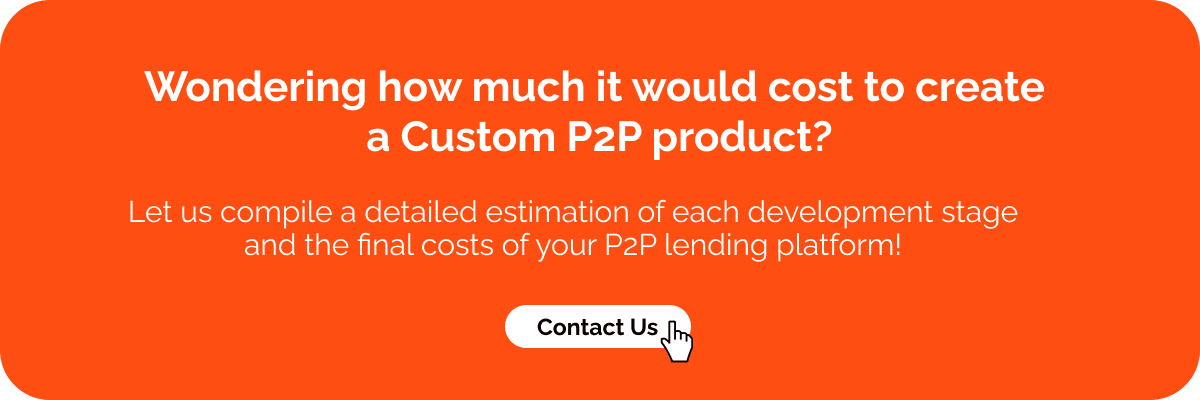Small and medium enterprises are in constant need of extra funding. They rely heavily on credit lines, business loans, and financial leases as the main sources of funds. Companies use this money to:
- Invest in assets
- Hire new employees and pay for employee training
- Launch new products and services
- Pay workers’ salaries
- Explore opportunities for new business and more.
Needless to say, since the needs may arise urgently, SMEs need instant access to more funding.
In this article, we uncover how fintech is reshaping SMEs and how alternative peer-to-peer lending apps are filling the gaps uncovered by traditional banks.
How Banks Work (Or Not) With SMEs
The traditional banking model required borrowers to pay a physical visit to an office and fill out many application forms.
As of today, many banks are launching fintech services and offering SME lenders online lending application processing, available anytime and from anywhere. The banks that failed to introduce online lending opportunities for businesses, saw a noticeable decrease in the number of SME clients during the pandemic.
Yet, in some cases, a bank loan is not a solution, and traditional banks have many downsides compared to alternative lenders.
- Long loan origination time
Banks need to run a complex loan application assessment process to check the borrower’s credibility and perform all the necessary verifications. This process is too lengthy for SME lending which needs instant access to funds.
- Hidden costs involved
Too often, a bank loan involves many hidden costs. Loan servicing and additional services like loan restructuring may involve expenses that borrowers are originally unaware of.
- Aggressive debt collection practices
If the borrower does not pay the loan on time, banks usually resort to fines and aggressive loan restructuring practices. SME lenders find it risky and thus unattractive.
- Strict loan security requirements
The banks’ security requirements are sometimes too strict for SME companies to handle. For example, a bank may require a borrower to ensure that a loan is secured against a family residence. This is one of the reasons why business owners are considering non-banks and alternative lending platforms.

Alternative Financing Solutions on the Market
Alternative lending is a growing industry these days. By “alternative”, we mean any type of money loan offered outside of traditional banking institutions. The alternative lending industry is growing and is predicted to soon exceed $334 million expanding at a CAGR of 4.7%.
Alternative lending has assumed many forms. As of today, the most popular alternative lending models are:
- Crowdlending
Also known as crowdfunding, this is currently its largest and most popular alternative lending segment. It accounts for 248.7 million value of transactions. As the name implies, this model involves getting a large number of individuals to invest in a business. This model is especially attractive for startup companies, as opposed to established SMEs.
- Peer-to-peer lending
Peer-to-peer lending involves the use of digital lending platforms and marketplaces connecting borrowers with investors. P2P platforms monetize on commissions and fees and use credit scores for the loan assignment process.
- Direct lending from non-banking institutions
NBFC (Non-banking financial companies) are financial companies that do not have full banking licenses. Investment companies, insurance companies, loan, and mortgage companies, as well as fintech infrastructure companies, are examples of non-banks.
How Fintech Solutions Change Lending
Alternative lending models could not appear without automation and acceleration of loan origination and servicing processes. Modern fintech software for lending leverages technologies like big data analytics, AI, machine learning, and robotic process automation (RPA) to process loan applications, and automate routine rule-based procedures.
The emergence of fintech infrastructure companies has made it easier for non-bank lenders to switch to alternative lending and speed up the lending software development. This, as well as the growing market demand for fast and easily accessible SME lending, has set the stage for the emergence of many non-conventional lending solutions.
The recently-emerged types of alternative financing solutions and loans for small businesses include:
- Credit lines
- Installment loans
- Microloans
- Merchant cash advances
- Invoice factoring
- Bridge loans
- Equipment financing, and more.
The ease of loan origination, transparency, absence of hidden costs, and flexible debt collection policies is what make alternative loans so popular among SME and small business owners.
Read also: How the Emerging Web3 Transforms Business Models
Learn about the new Web that will change everything we know
Top 5 Alternative P2P Lending Platforms
If you’re considering fintech software development and want to build an attractive platform for SME lending, looking at the existing solutions could set you on the right track.

Here’s an overview of the top alternative lending tools that are currently disrupting the ways SME companies and private lenders are receiving lending services.
#1. LendingClub
LendingClub is one of the best-known platforms for P2P lending and also the top-rated one. The platform connects borrowers and lenders and makes sure they meet the optimal criteria for these roles. The borrower’s credit score, for example, should be at least 600 to apply for a loan. The maximum loan you can get is $40,000.
On the downside, borrowers can only change a loan repayment term once, and there’s a fee for loan origination. There’s also no mobile app available for loan management, although the loan application procedure is 100% digitized.
#2. Upstart
Created by former Google employees, Upstart boasts to be using both alternative and traditional criteria for AI-driven loan application assessment. Instead of relying only on the FICO scores, the platform will take into account the borrower’s job history and education. The maximum amount of money users can borrow is $50 000. The minimal credit score is 1000$, although Upstart may originate a loan for users with no borrowing background.
The cons are like LendingClub – no app to manage a loan, limited choice of repayment terms, and a fee for loan origination.
#3. SoFi
SoFi is a non-bank company, which works a lot like how a bank works, but with a substantial difference. Customers can open hybrid checking and savings accounts, apply for personal and student loans, and track monthly spending. For small businesses, SoFi Lantern offers a range of credit products targeting almost any type of business needs in cooperation with multiple lending providers.
SoFi doesn’t charge any fees for personal loans and offers a mobile app for managing loans, earnings, and savings. On the downside, loan approval takes a long time, which could be a turn-off for many customers.
#4. Prosper
A peer to peer lending software for lenders with good credit history, Prosper is one of the oldest lending platforms on the market and has served thousands of clients over the past decade. It’s also one of the leaders in crowdlending. The required credit score is not disclosed, but it is reported to be 640.
The platforms offer an opportunity to apply for a joint loan, and a minimal investment amount is only $25%. On the downside, obtaining and servicing loans involves many fees and there are only two loan refinancing terms available.
#5. Avant
Avant is believed to be the best peer to peer lending platform for fair credit and flexible loan options. The platform has received excellent feedback for transparency. Soft credit checks are available so that the borrowers can plan their budgets, and all fees and rates are explained in detail. The borrower can receive funds the next day, which is an indisputable advantage.
On the downside, the platform charges large loan origination fees, and there is no joint loan option. There’s also no direct payment of consolidated credit, a feature offered by most of the Avant competitors.
As you can see, these P2P lending platforms have both advantages and downsides, so there will always be a market demand for a more balanced solution. Looking at the pros and cons of the existing loan applications will help you evaluate the optimal functional and non-functional feature set for your own P2P lending platform.
Things to Know Before Considering P2P Lending Platform Development
If you’re planning to build a peer to peer lending platform, below are some of the key things you should consider before you start creating digital lending solutions.
P2P lending software advantages for borrowers:
- Faster and easier loan origination
- Flexible funding and spending options
- Lower loan interest rates
- Lower credibility requirements
P2P lending software advantages for investors:
- Better earning capabilities compared to other lending methods
- Broaden the range of available investing options
- Flexible amounts of investments
The role of a platform:
It is also necessary to understand the role that a P2P lending platform plays in the process of P2P loan origination and servicing. The platform serves to connect borrowers and investors, assesses credit risks for investors, evaluates the borrowers’ credibility, and enables lenders to conduct payments through the platform.
At the same time, the P2P platforms bear no risks and have no control over the profits (or financial losses) of investors.
Some of the key aspects to take into account before the development of lending software include:
- Industry laws and regulations
Fintech is one of the most regulated industries, so you must follow many laws that ensure customer data protection. Adherence to these laws will impact your app design and user journey.
- Secure user verification and authentication
It is important that the loantech applicants are verified users with proven identities. The process of verification should involve confirming and verifying users’ accounts, taxing, contact, and income details.
- Risk assessment
To ensure minimum risks, borrowers should meet the following criteria:
- FICO score of at least 560
- At least one account in a bank
- Low debt-to-income ratio
- Good credit history
- Usability and Design
Great user experience could propel you ahead of competitors. So make sure your app has all it takes to ensure seamless navigation and quick loantech application and processing. A mobile app version is also something most users will definitely appreciate.
- Important partnerships
Fintech solutions development will require you to enter many strategic partnerships. Most importantly, your success will depend on your banking and your software development partners. So make sure you collaborate only with trusted and reliable experts.
How Can You Make Money With P2P Lending Platform?
Bearing no risks and acting as mediators between parties, how do P2P lending platforms generate revenue? Normally, P2P lenders will charge the borrowers fees for loan origination and servicing. There are two distinct fee categories:
- Advance Fees
These types of fees are charged once, immediately after a loan has been approved. The fees usually range between 1% and 6%, although some firms charge no upfront fees for loan origination. The fee amount is normally not disclosed until the loan approval is complete.
- Ongoing Fees
These fees are charged over the course of an entire loan servicing term. The platform usually capitalizes on margins charged on top of interest rates of regular payments. For example, if a borrower makes a payment with a 6,5% interest rate, the platform’s margin may equal 1,5%.
What is the Future of Peer-to-Peer Lending Apps?
P2P lending is one of the fast-developing industries these days. Driven by the technological advancements of the post-industrial era and the gap between market demand for loans and banks’ limited capabilities to serve all user categories, the market for P2P lending is estimated to reach $1.7 trillion by 2032.
The small business lending segment is predicted to play a significant part in the development of peer-to-peer lending in years to come. This is largely due to the growing number of small businesses in the Asia Pacific region, and their need to attract funds to thrive and develop.
How Visartech Can Help to Develop P2P Lending Software
At Visartech we are already familiar with alternative lending software development. Our expertise includes an award-winning loan management app aimed at helping users lend and borrow money from their close friends and family members.
We start by helping you implement your idea and find a tech solution to solve business challenges or achieve the specific business goal. We will also offer you a range of services you can choose from. We can start with business engineering and help you define a roadmap for your business, proceed with building an MVP and take you through all the stages of software solution development.
Our technology stack includes Python, MySql, and AWS cloud for building secure solutions for fintech. At Visartech we focus on multiplatform development. So the platforms we build will be available on mobile operating systems like iOS, Android, and Windows, and desktop systems such as Linux, Mac, and Microsoft Windows OS.
We choose Angular and React.Js for the front-end development of web and mobile applications (respectively) delivering a smooth user experience similar to that of a desktop app. Used in combination with the Electron library, Angular and React are also a perfect fit for building cross-platform and standalone apps. Our frameworks of choice for mobile development are React Native, Xamarine, Flutter, Ionic, and Framework 7.
Read more: Behind the Scenes of Development Process: The Visartech Workflow
Learn the way our development team organizes their working process
Core Features of Peer-to-Peer Lending App Like LendingClub
To enjoy market success, a P2P lending platform should offer something distinctly unique, that would set it apart from other platforms. There are app features, however, which are absolute must-haves for all types of lending platforms.

Below is a checklist of basic features that should be included in a lending software product like LendingClub.
Money Loan Calculator
The money loan calculator feature enables users to see how much money they would have to spend on monthly loan payments and enables them to plan their expenses in advance. You can enter different loan amounts, interest rates, and terms into the calculator, compare other loans and determine what best suits your needs.
Lender/Borrower Matching
In SME lending apps, this feature should match borrowers’ loan applications with lenders willing to invest in their businesses and projects. Criteria for finding the optimal borrower/lender may include your industry type, age of business, location, and financial need.
Document Scanner
A loan application involves submitting a lot of documents,which contain confidential information about both sides of the loan. So make sure your app includes a built-in document scanner.
Credit Score
The borrower’s credit score will be the main thing that lenders pay attention to, as they pick the potential areas for investments. It may also affect the interest rate and other terms of any loan or other credit account for which you are eligible. With that in mind, make sure you include it in a basic feature set.
Loan Origination
The process that a person must go through to get a loan. What’s important at this point in the app, you ask? The loan origination feature should be as convenient and quick to access as possible.
Auto Investment
This feature uses artificial intelligence to drop the guesswork and automatically picks the most interesting investment opportunities for lenders.
How Much Does It Cost to Create a Custom P2P Lending Platform?
The app development costs of building a P2P lending platform will depend on the complexity of your solution as well as on the development timeline. Yet, there are main factors that influence the cost such as:
- The development team structure and expertise;
- Chosen development tech stack;
- The number and complexity of app features;
- Type of selected platform (mobile or standalone);
- The geographic location of the development team.
Generally, the app development cost really depends on the location of your development team. However, the professional expertise rate varies from $50 to $120 per hour.
Read also: How to Save Money on a Web Project for Businesses
Learn how to select the best tech stack for your web application
To get a complete understanding of P2P solution costs, let’s get through the app development stages and features in detail on the example of the LendingClub prototype.
The frontend development of the loan software involves the following tasks and features:
| Tasks/Features | Optimistic, Hours | Pessimistic, Hours | Time, hours |
| Static Website | 40 | 56 | 48 |
| Login/Signup | 8 | 16 | 12 |
| Profile | 24 | 32 | 28 |
| Main dashboard | 32 | 40 | 36 |
| Banks connection | 16 | 24 | 20 |
| Credit score check | 16 | 24 | 20 |
| Documents upload | 24 | 32 | 28 |
| Loans management | 32 | 40 | 36 |
| Social features | 16 | 24 | 20 |
| Deploy | 16 | 24 | 20 |
| Total | 224 | 312 | 268 |
Clearly, the frontend part of such a platform might take from 224 to 312 hours of app development.
Consequently, if you take the average rates of $50-120 per hour, the front-end development cost of such a lending platform will be from $13,400 to $32,160.
Project documentation, infrastructure, and backend development are the other parts that go into the P2P app development process. Let’s see the overall estimation of them all.
| Tasks/Features | Optimistic, Hours | Pessimistic, Hours | Time, hours |
| Project Documentation | 152 | 216 | 184 |
| Infrastructure | 80 | 120 | 100 |
| Backend | 344 | 472 | 408 |
Taking the average range of development hourly rate between $50 and $120, these lending platform development stages will cost:
- Project Documentation: $9,200 – $22,080
- Infrastructure: $5,000 – $12,000
- Backend: $20,400 – $48,960
So how much does it cost to develop an MVP of a P2P lending platform like LendingClub?
Totally, the lending platform development with the core features required for an MVP may cost from $48,000 to $115,200.
What is the structure of an app development team that can create a lending platform like LendingClub?
Optimally, the engineering staff that can help you to build a P2P product is led by the Project Manager. The responsible party for the product quality is the QA engineer. The rest is grouped under several development teams.
- RD and Doc Team:
- Business Analyst
- DevOps Team:
- Architect
- DevOps
- Design Team:
- Web Designer
- Node.js Team:
- Node.js Lead
- Node.js Developer
- React Team:
- React Lead
- React Developer
Read also: How to Optimize IT Infrastructure and Unlock the Cloud Potential
Check the ways of making your IT Infrastructure performance better
Certainly, every project involves different approaches while implementing very suitable features. This rough estimation provides an understanding of approximate lending platform development costs.
The Bottom Line
The SME lending niche has a lot of untapped potential. While banks are unwilling to take risks and assign loans to unsecured clients or clients with low credit ratings, alternative lenders are taking a different approach. With peer-to-peer lending offering higher flexibility, lower rates, and wider investment opportunities, the market for the peer-to-peer lending apps for small and medium businesses is set for continuous growth.
Yet, building a P2P lending platform involves taking care of a lot of nuances and complexities. Ensuring seamless user verification, security, usability, and compliance is a challenge, especially if you are new to fintech software development. An experienced development partner, on the other hand, will guide you through all the stages of P2P software development and help you build a successful lending app.
Interested in lending software development? Contact us now to schedule a free consultation!





